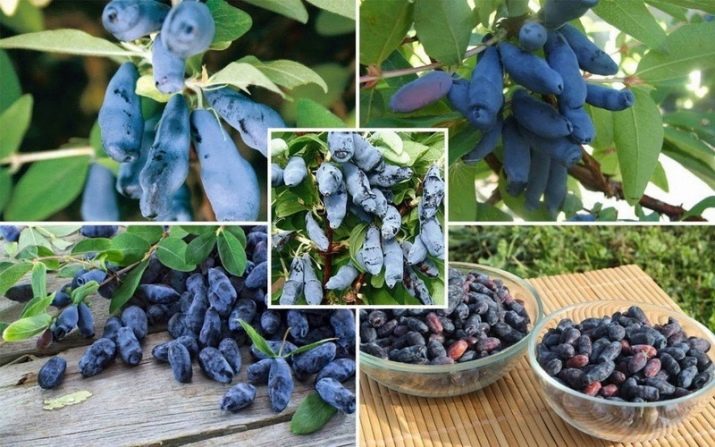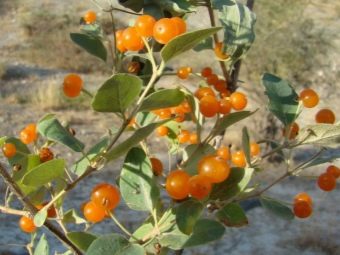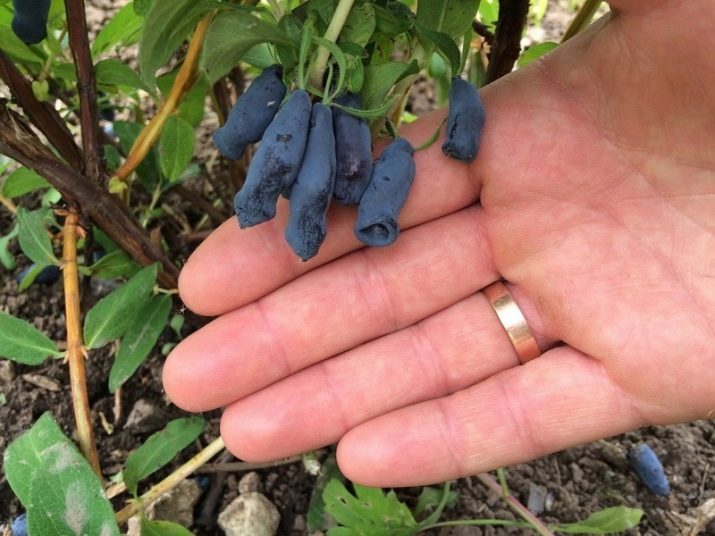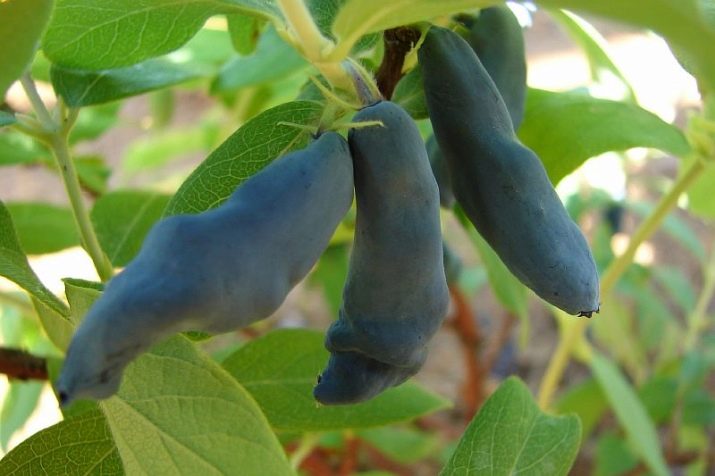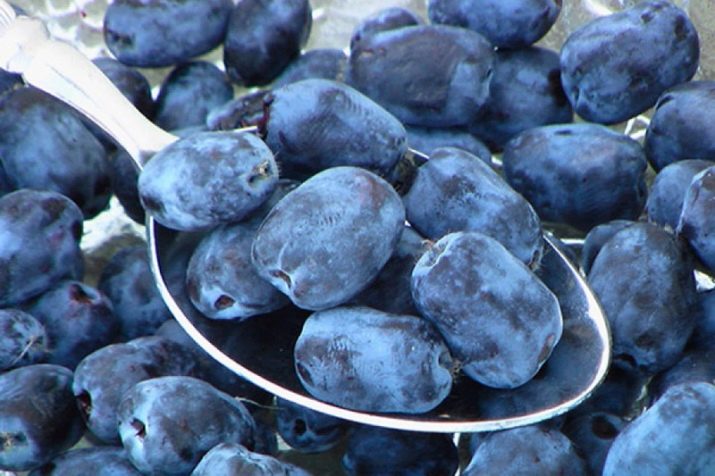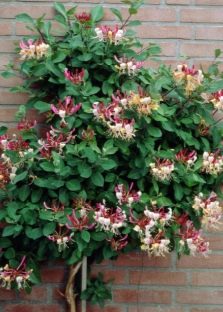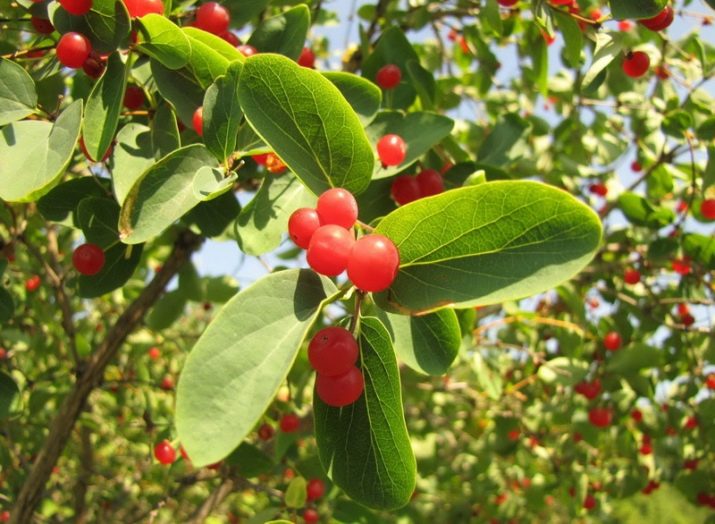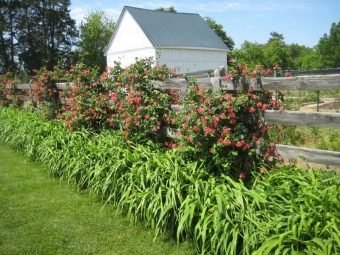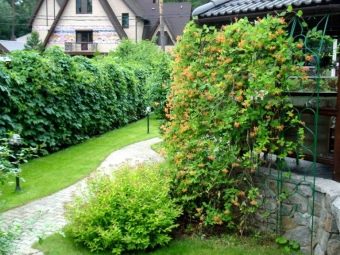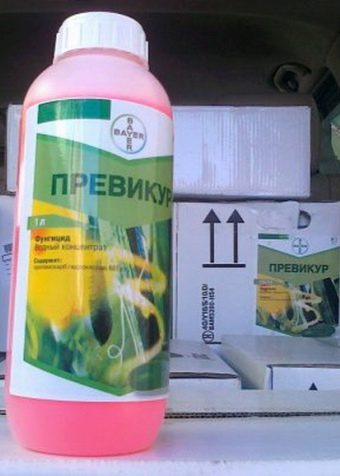Honeysuckle edible: types, varieties and tips on agricultural technology

Garden edible honeysuckle is not as famous and popular as many other shrubs.Probably, many people are wary of the name of the plant - “wolfberry”. That is how the old Belladonna was called, as well as buckthorn, daphne and many other similar bushes. However, few people know that most varieties of honeysuckle are quite suitable for human consumption, and in terms of their medicinal properties they even surpass the fruits of most cultivated shrubs.
Plant description
Honeysuckle is a low shrub with dense branches, it can be spreading and upright. In previous years, only a climbing species was cultivated, it was widely used for vertical gardening of fences, arches and terraces, but today, for the most part, they grow varieties that, in addition to beautiful flowering, can also produce tasty fruits.
The plant can be bushy or erect, the leaves are ovate, pointed at the ends, the plant sheds all the leaves for the winter, but even in winter it does not lose its ornamental quality, since the young shoots have a rich purple hue. This is quite unusual and interestingly contrasts with white snow.
Flowering begins at the end of May, while the plant is literally from top to bottom covered with abundant buds of yellow. Closer to autumn there is a scattering of small fruits, often they are poisonous.
From the beginning of the appearance of flowers to fruiting, it takes 1-1.5 months, so you can eat blue-blue fruits in the middle of July. Some varieties are black in color. The berries are quite large, their length varies from 1.5 to 3.5 cm, and the diameter is from 1 to 1.8 cm. The weight of each is from 0.5 to 1.5 g.
Depending on the variety, the shape of the fruit can be spherical, cylindrical, oval, pear-shaped, teardrop-shaped and spindle-shaped. The pulp of the berries is very juicy, the skin is thin with a slight waxy coating.
The seeds are very small, almost imperceptible to the eye, they are flat, slightly rounded, painted in a light brown color. Each fruit contains about 10-20 seeds.
The taste of edible berries is rather unusual - sweet and sour, a bit like blueberry. Berries have healing properties, they contain a large amount of vitamins and minerals and are extremely useful for humans. The plant is rich in vitamin C, the content of which can be compared with lemon, orange and other citrus fruits. In addition, the product contains vitamins of group B, as well as retinol and nicotinic acid. Calcium, copper, boron, iodine, magnesium and potassium can be distinguished from mineral elements - such a combination of trace elements helps to maintain optimal functioning of the nervous, cardiovascular, musculoskeletal and immune systems.
Honeysuckle has a low calorific value, per 100 g of fruit accounts for only 30 calories and 8 g of carbohydrates, proteins and fats in the fruits are missing.
Honeysuckle is rich in organic acids, pectin and tannins in large quantities.
The concentration of vitamins and minerals is influenced by various climatic factors, such as moisture level, soil composition and average air temperature, for example, in drought conditions, fruits contain more tannins, and in humid climates the berries are characterized by an increased amount of monosaccharides.
How to distinguish from inedible shrubs?
One of the most common issues among gardeners is related to the difference between edible and toxic culture.
The cultivated plant has dark blue berries, but the red fruit speaks of the toxicity of the variety. Surely many people have heard the notion of “wolfberry”, which grows on wild bushes and has a red-orange color, such berries are located on branches in pairs, often coalesced and differ by a shortened stem. It is strictly forbidden to use such berries inside - they are extremely poisonous and can cause irreparable harm to humans.
Inedible honeysuckle can most often be found wild in the forest.
However, nowadays, breeders have bred some garden varieties of honeysuckle, the fruits of which have an orange color - these are “Golden honeysuckle”, “Glen honeysuckle”, “Korolkov’s honeysuckle” and some other varieties that are highly decorative during the whole growing season, therefore they are planted in gardens, parks and squares.
Sorta
In total, science knows about 200 different types of honeysuckle, in Russia there are about 50 varieties, for the most part these are poisonous plants, the fruits of which differ in yellow-orange or red shade, and edible ones are less common.
The most popular varieties for cultivation in the Leningrad region are Nymph, Julia, Laura, Malvina, Lenarola.
In the Moscow region, for central Russia and Byelorussia, such species as Sinichka, Fortuna, Kingfisher, Heap is small and Sinichka are optimal.
For the Urals are suitable "Sinegrudka", "Resistant", "Blueberry" and "Sorceress".
In Primorye, Dolphin, Blueberry and Rassvet are cultivated, while in Siberia preference is given to Cinderella, Gerda, Sibiryachka, Selene and Roxane.
To create original landscape compositions, different varieties of decorative honeysuckle are used - these can be either shrub plants or lianovid forms.
One of the most popular climbing species of honeysuckle is capricoleum, as well as fragrant honeysuckle. This exotic plant loves well-lit areas as well as fertile, well-moistened soils. Flowering is very abundant, with the inflorescences emit a rich fragrant aroma, which only intensifies closer to the night. In late summer, inedible orange fruits appear on the plants. They can not be eaten, but for decorating the site they are truly indispensable.
Caprifol grows up to 4-6 meters in 5-6 years, while the plant does not require special conditions and grows well on garden soil. The great advantage of the variety is its good winter hardiness - the plant does not require special shelter for the winter and calmly transfers winters in the territory of most regions of our country.
The best varieties of honeysuckle recognized:
- Belgica - with its lilac and pink flowers;
- Harlequin - blooms beige and gently cream shades;
- Munster - differs in white inflorescences and a thin red border.
But Graham Thomas is considered the most amazing of all caprictums - it has delicate yellow openwork inflorescences with a thin elongated tube.
"Brown fuchsia", perhaps the most exotic of all the honeysuckles, it attracts attention with its unusual large flowers of orange blossom, which literally fall asleep bush from top to bottom. It is noteworthy that this plant blooms 1.5-2 months. This variety is not as high as the rest of the vines - an adult plant does not exceed three meters in height. This culture does not tolerate frosts, so in regions with cold winters it needs shelter.
"Serotina" is, without any doubt, one of the most beautiful lianas, which is distinguished by exceptional decorative effect throughout the growing season. The plant has an unusual bright foliage and abundant prolonged flowering: if you remove dried inflorescences, you can enjoy flowering until September. This plant also badly tolerates frost, so it can be cultivated only in the southern and central regions, where it requires mandatory shelter for the winter.
Shrub honeysuckle is also quite popular in the landscape, but since it is much less decorative, it is used mainly for the organization of hedges, and also for the design of alpine slides.
Most often, our compatriots grow Tatar honeysuckle in their household plots, which grows up to 1-2 meters, and at the end of spring blooms with white and pink inflorescences. By August fruits of bright shades are formed. The plant is poisonous, eating berries is not recommended.
There is another rather original variety of shrub form - Alpine. This is a short-growing plant, which does not exceed 50-80 cm. In May it is covered with a light-green cloud of flowers, replaced by dark blue berries. Note: despite its purple hue, the alpine honeysuckle berries are inedible.
Application in gardening
Honeysuckle - is one of the most beloved landscape designers of plants, it is quite unpretentious, but has an incredible aroma and exceptional decorative. Interesting arches, exotic columns can be made from honeysuckle vines, gazebos, fences and walls can be decorated.
Designers with a great desire to include honeysuckle in the composition of various wood-shrub compositions that delight the eye and bring great pleasure.
The amazing aroma of the plant is not ignored, which is why some varieties are planted solely for flavoring individual parts of the garden. Of course, honeysuckle is indispensable in design, if you need to hide unattractive areas from prying eyes - an ugly fence, an old barn or a crack in the wall.
Honeysuckle goes well with cherry plum, common hazel, evergreen iberis and other cultures.
Shrub varieties are used to create hedges, they are in perfect harmony with coniferous plants, as well as flowering shrubs such as weigela, deutzia or Chubushnik. Very attractive looks tandem honeysuckle with climbing roses.
Growing secrets
Before deciding on planting honeysuckle in your garden, pay attention to the fact that this is a cross-pollinated crop, therefore several varieties should be grown in one area, only then the plant will not only bloom, but also give decorative fruits.
It is better to buy seedlings in a specialized nursery, this is the only way you can be sure that you are buying exactly the sort that you plan to grow. It is optimal to take planting material with an age of no more than 2-3 years, such a seedling will begin to bear fruit in two years. Before buying, you should carefully examine the young sapling: its stem, leaves and roots should not have any damage, the twigs should bend well, the root system should be well developed and branched, with no signs of damage to the integrity of the roots.
You can not buy too long seedlings - as a rule, they do not take root well, and, however, too short, too, will not work, because in most cases they have poorly developed roots.
Honeysuckle is planted along with an earthy clod in April, while the buds have not yet blossomed. It is advisable to choose a sunny, well-lit place.
But you can plant a sapling in the fall, for this is most suitable mid-September.
The planting pit is prepared in advance - for a start, they dig it up to a depth of at least 40 cm and fill it with compost at the rate of 2 buckets under each seedling. And also pour a liter of ash infusion and report on 3 tbsp. l superphosphate and urea. The earth prepared in this way is watered and covered with polyethylene for a week or two. After that, the film is removed, dig a hole of such a size that the roots are located freely, straighten all the roots, fall asleep with soil and thoroughly watered.
The surface should be mulched; peat, needles, sawdust or straw are suitable for this.
The distance between the seedlings should be about 1.5 meters or more. At the same time try to alternate varieties to get maximum pollination.
The plant responds well to top dressing. However, they need to be produced only from the third year after disembarkation - the first time, it is enough for the nutrients that are brought into the hole when planted.From this point on, 25 g of ammonium nitrate or urea should be poured over the snow each year, and after the snow has melted, water each tree with a bucket of liquid, rotted humus, diluted with water.
As a fertilizer, it is better to use ready-made complex formulations that contain high concentrations of phosphorus and potassium, since during the flowering period an excess of nitrogenous substances can lead to abundant growth of the vegetative mass to the detriment of flowering and the formation of fruits. In the autumn cultivation of the land under a bush make half a cup of crushed ash, such a measure would saturate the soil with potassium and normalize the acid-base balance.
If you grow shrub honeysuckle, it is necessary to regularly carry out sanitary and formative pruning. However, keep in mind that pruning of honeysuckle can only be sanitary, if you cut short the shoots of vines, then next year you can be left without flowering at all.
Under unfavorable natural conditions, honeysuckle often suffers from fungal diseases - with prolonged rains, the plant often encounters powdery mildew, rust, and peronospora. Sick leaf plates start to become covered with white bloom, yellow and gray spots, and soon they fall off completely. The diseased plant should be sprayed with Topaz, and Previkur and Scor are also very effective.
Nitrogen-fed plants often encounter garden pests such as the shield, aphids, spider mites and whiteflies. Their larvae suck up the plant sap, pollute them with their sticky decay products, on which fungus can later appear. From pests well help drugs "Fitoverm" and "Mospilan".
In order to prevent each spring, you need to spray a young plant "Epinom" or "Zircon".
See how to plant and care for honeysuckle in the next video.

